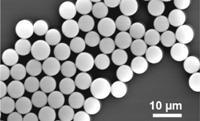New microspheres offer a more stable solid support for fluorescence detection in biomolecule screening.
A new way of screening biological molecules is now in sight thanks to research by Australian scientists.
Modern bioresearch often involves the screening of proteins or DNA molecules for particular sequences. One approach has been to use probe molecules attached to the surface of tiny spheres. Once the target molecules in the sample are recognised by the probes, they can be easily separated out and the target molecule identified. When the spheres, the probe or the targets are labelled with a fluorescent dye, the recognition process can be measured and studied much more effectively.
Matt Trau and colleagues at the University of Queensland have developed a new kind of organosilica microsphere that has fluorescent dye molecules covalently attached to it. The spheres are about ten microns across and are stable under conditions that cause other kinds of microspheres to leak dye.

These new microspheres have been used to detect oligonucleotides with a particular sequence by using oligonucleotide probes of complementary sequence that are tethered to the microsphere surfaces.
More significantly, the detection of a single nucleotide base mismatch has been made possible by observing the reduction in fluorescence that occurs when the bases are not exactly matched - something which may prove useful in the detection of single nucleotide polymorphisms.
Similar microspheres have also been used to explore the peptide sequence specificity of proteases. These employ short fluorescently-labelled peptides attached to the microsphere surface that can be removed by the target enzyme when the correct sequence of the peptide is recognised. In this case a loss in microsphere fluorescence shows a positive result.
The future certainly looks bright for these new microspheres, particularly in the areas of genomics, proteomics and drug discovery.
Michael Smith
References
C R Miller, R Vogel, P T Surawski, S R Corrie, A Rühmann and M Trau, Chem. Commun., 2005, 4783 (DOI: 10.1039/<MAN>b509503d</MAN>)






No comments yet